The typical modern inbox is overcrowded with promotional emails, newsletters, and other brand communications. So, if you want to set yourself apart from the competition, you need to be able to cut through the clutter and show consumers that you’ve got something meaningful to offer. One effective way to do that is by mastering the art of email personalisation.
What is Email Personalisation?
Put simply, email personalisation refers to the process of tailoring email communications to a specific recipient. This is usually done using data such as name, location, age, gender, behaviours, and more.
The main factors to consider when personalising your email communications are:
- Relevance
The average worker receives at least 121 emails per day, so personalisation is a necessity to stand out from the crowd. You’ll need to offer them highly relevant content if you really want to grab their attention. If your email’s content doesn’t directly impact and resonate with the recipient, it’s likely to be quickly relegated to the bin.
- Timing
Personalised emails also need to be timely – i.e. the right kind of content needs to reach them at the right stage of their customer journey with you. You can determine exactly what a recipient needs to see and when by gathering a variety of information about them.
For example, if they search for something specific on your website, you can use this valuable insight into their current needs and interests to craft a tailored email that perfectly meets those needs.
- Human Connection
Making it clear that your email communications are coming from a real person is also key to engaging your audience. This human-to-human connection lies at the heart of email personalisation success.
You can take many different approaches to email personalisation, some of which we’ll delve a bit deeper into later on. Ultimately, though, sending relevant content to the right person at the right time is a tried and tested way of boosting engagement and conversions.
Understanding the Power of Personalisation
Modern consumers will not be satisfied with just a generic email blast; they want relevant, personalised content that addresses their individual needs and interests.
According to 2021 research from McKinsey & Company, 71% of consumers now expect personalised marketing, while a staggering 76% get frustrated when a business’s communications aren’t personalised.
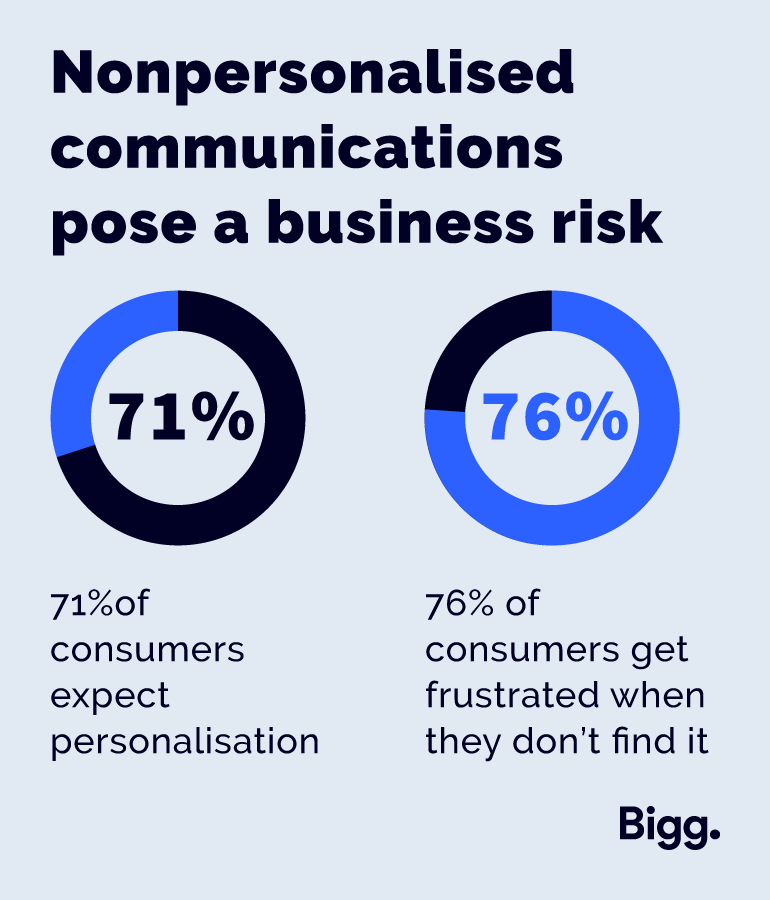
Additionally, personalisation appears to influence buying behaviour continually throughout the customer lifecycle:
- 76% of consumers are more likely to make an initial purchase from a business offering personalised communications.
- 78% are also more likely to then make repeated purchases and recommend the business to friends and family.
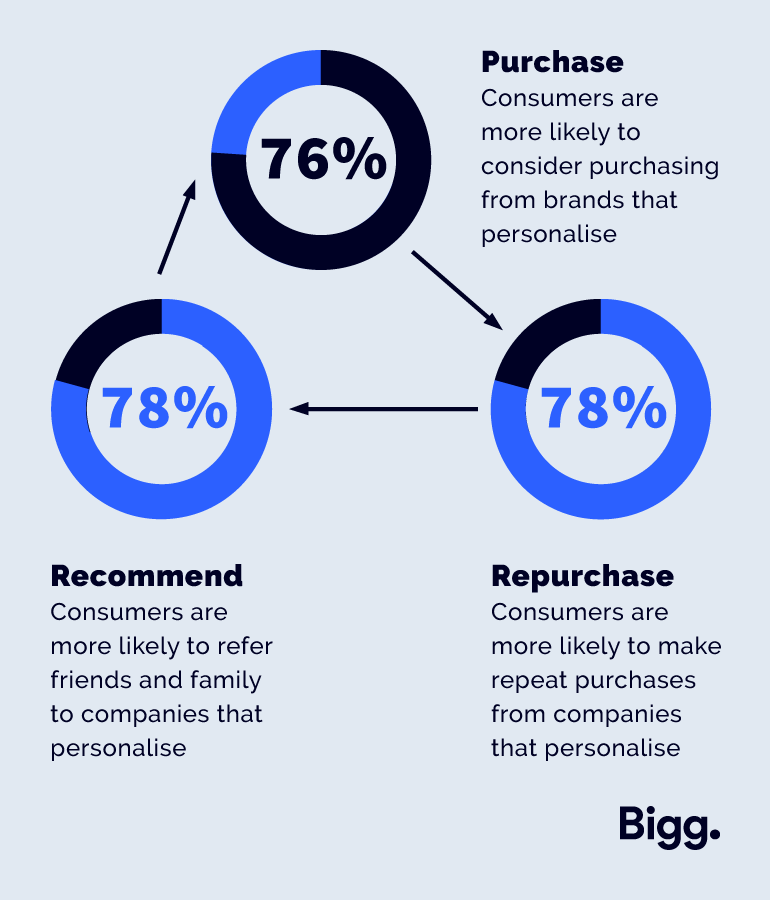
This just goes to show that failing to personalise your communications could put you at risk of losing valuable customers to businesses that have embraced personalisation.
The dangers don’t end there: you may begin to fall behind your competitors on the revenue front, too. Research has suggested that brands that personalise their marketing could generate as much as 40% more revenue than those that don’t.
So, the power of personalisation is clear. Not only do consumers want it and expect it, but it can also help to:
- Increase email open rate
- Boost engagement
- Improve brand loyalty
- Spread brand awareness
- Increase conversions throughout the customer lifecycle
- Maximise Return on Investment (ROI)
The Three Tiers of Personalisation
How exactly can businesses begin to personalise their email communications, you ask? There are many ways to tailor emails to a particular audience, some of which you probably come across every day in your own inbox.
They can be loosely categorised into three tiers of personalisation: the basics, segmentation, and advanced personalisation.
- The Basics
At the most basic level, there are three main places where you can leverage personalisation in your emails. These are:
- “From” name – Your business’ name or a specific product/service name.
- Subject line – The opening lines that recipients see in their inboxes.
- Preview text – The short one-liner continuing on from the subject line.
Studies have shown that personalising at least some of these key elements has a direct positive impact on open rates.
This could involve strategically integrating details like your recipient’s first name or their specific attributes into one or more of these elements. For instance, consider tailoring your subject lines and/or preview text based on location, job title, gender, age or any other useful insights derived from your audience data.
Combining the recipient’s first name with a compelling subject line – for example, ‘Lucy, our spring sale starts now!’ or, even better, ‘Lucy, your favourite items are on sale!’ – can enhance personal connection and engagement. A/B testing different personalised subject lines and CTAs can further improve open and click-through rates, distinguishing your emails in a cluttered inbox and increasing conversions.
- Segmentation
Segmentation involves categorising your email list into distinct groups based on common attributes. This process enhances understanding of your audience, allowing you to then tailor your email communications to similar behaviour groups. Utilising data from each of your segments enables a deeper level of personalisation, moving beyond the more generic tactics like using recipients’ first names.
A fashion brand might initially divide its email subscribers by gender demographics, separating males and females. However, there’s room for improvement. By further segmenting these lists based on geographic demographics, the brand can tailor product suggestions according to local weather patterns during various seasons.
- Advanced Personalisation
Advanced email personalisation goes beyond basic audience attributes, offering a much more immersive experience. Those who’ve mastered the art of email personalisation can deliver email campaigns that feel like they were made for an individual recipient. You want your customers to think “Wow, this brand really gets me!” upon reading your emails.
Strategies employed at this level of personalisation could include triggered emails based on customer actions, like sending a discount after cart abandonment. This kind of email workflow might look like this:
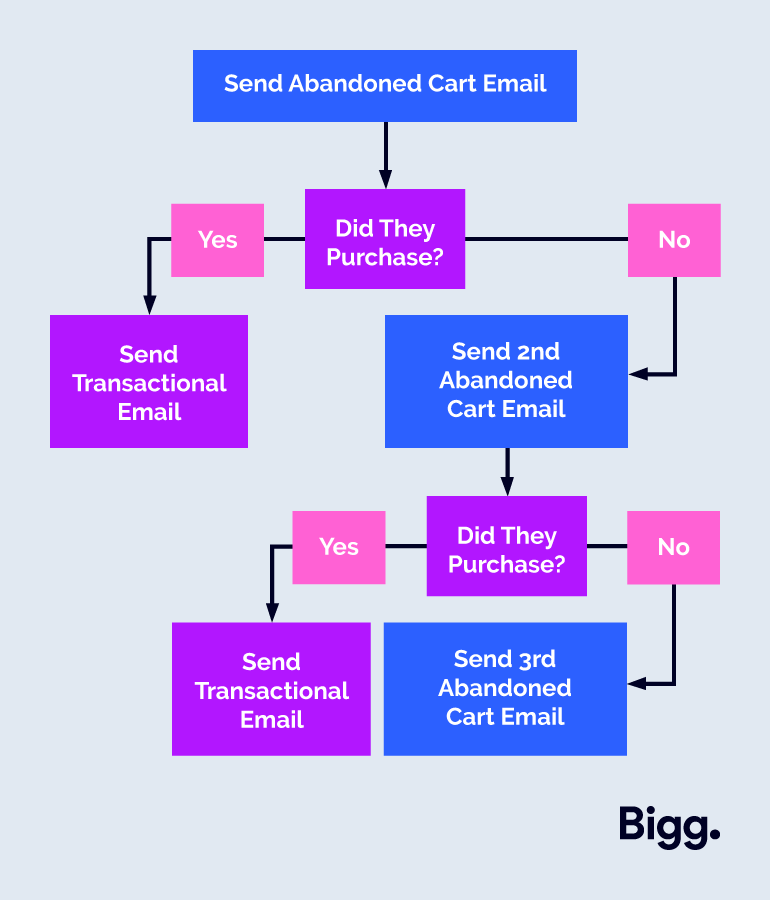
Dynamic content within emails, such as countdown timers or live shipment tracking, further enhances personalisation by providing real-time information to recipients. These strategies significantly improve relevance and engagement, moving recipients along the buyer journey effectively.
Best Practices for Email Personalisation
Using email personalisation is a game-changer for businesses looking to connect with their audience, foster brand loyalty, and drive more sales. If you’re new to this, here are some handy tips to kickstart your journey:
Define Your Goals
Establish what you want to achieve and how you’ll measure it. Monitor metrics like click-through rates for website traffic, unsubscribe and churn rates for loyalty, and customer journey actions for new prospects.
Personalise the “From” Name
Matching certain recipients to specific “From” names can help to encourage interaction. A study by SuperOffice revealed that 45% of email subscribers would base their decision on whether or not to open an email on the sender name alone, so it’s important to get this right.
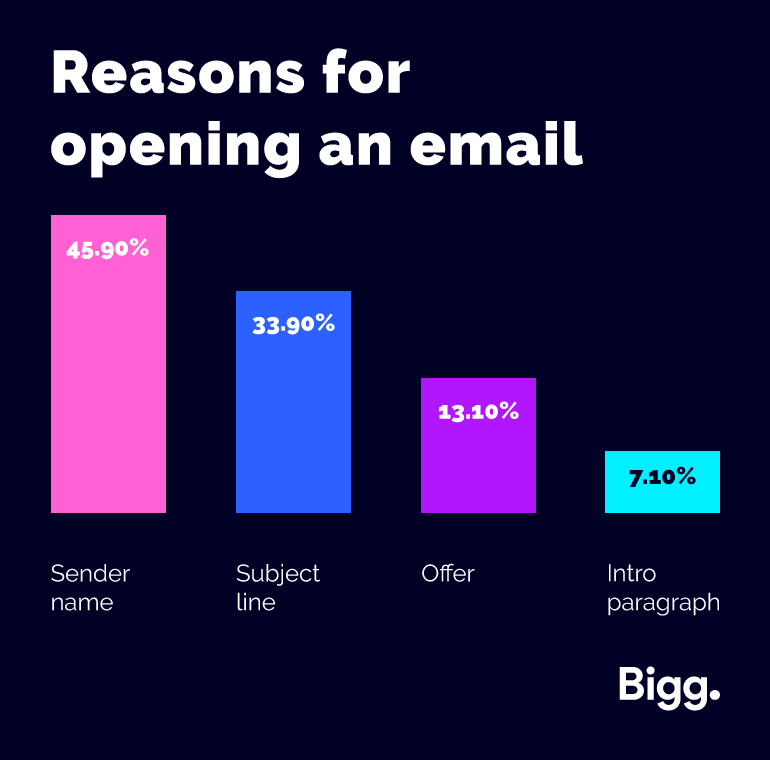
To give the impression of real human connection, you could even make the sender a specific staff member’s name. Some research has suggested that this can increase open rates by as much as 35%!
Address the Recipient Directly
This fosters a sense of connection and relevance, creating a more engaging experience for the recipient and increasing the likelihood of them opening and interacting with the email content. Personalisation also helps to establish trust and demonstrates that the sender values the individual recipient, ultimately contributing to the success of the email campaign.
Research has shown that even simply using the recipient’s first name in the subject line can increase open rates by 26%!
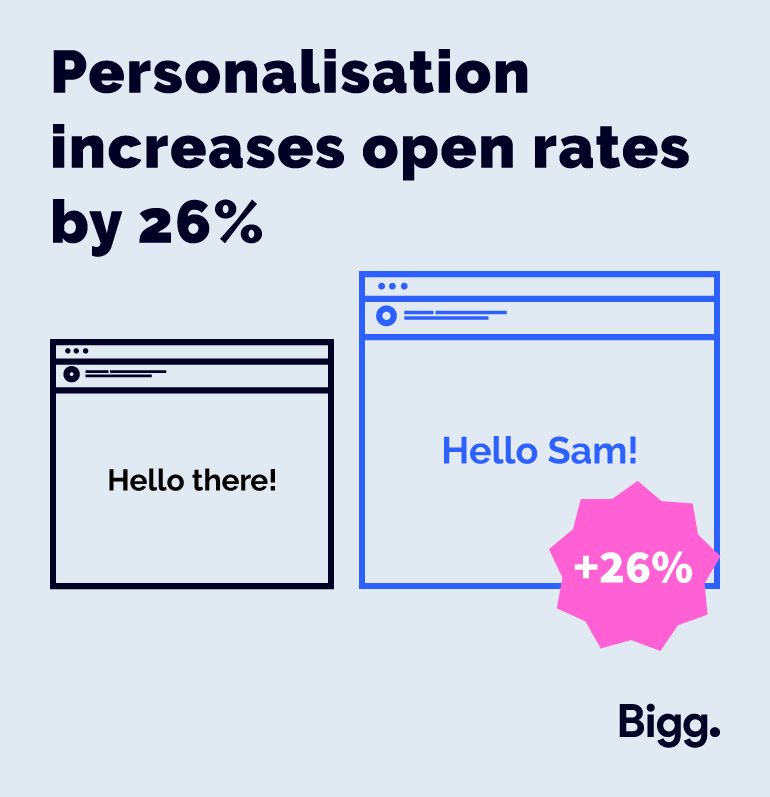
Write Captivating Preview Text
This element allows you to provide the recipient with more context, intrigue your audience, and really highlight the relevance of the content. This increases the chances of them opening your email.
Gather and Segment Customer Data
By collecting and examining data like previous purchases, online activities, and demographic details, you can craft more precise and relevant messages for each segment of your email roster.
Comply with Privacy Regulations.
It’s vital that you adhere to the General Data Protection (GDPR) when collecting data from consumers. Here are some key guidelines to follow:
- Make sure you have clear permission before emailing anyone.
- Avoid using pre-selected checkboxes on forms.
- Keep your website’s privacy policy current to outline how you collect and use data.
- Have all collected consumer data ready to share if asked.
- Be ready to remove subscriber info upon request.
- Refrain from selling subscriber details to third parties.
Send Emails at Optimal Times
Ensure your emails reach your audience when they’re most likely to engage. Consider their time zone and preferences to optimise delivery. Marketing automation tools allow you to identify peak engagement times and schedule your email sends accordingly.
Determine What Works With A/B Testing
A/B testing splits recipients into two groups to compare email variations and determine which design performs better. This allows you to optimise future email campaigns to improve metrics like open rate and click-through rate, as well as prevent human bias.
Don’t Overdo It
Although personalisation can be really effective, it’s vital to excessive personalisation. Refrain from overloading with personal details or assuming too much about your customers, as this could seem intrusive or unsettling.
By following these expert tips, you can begin to build a more effective email personalisation strategy that engages your audience, helps to cultivate a loyal community, and drives more opens and conversions.
Purposeful Email Marketing Services from Bigg
If you’re looking to step up your email marketing efforts, look no further than Bigg. We are a digital marketing agency with lots of experience in delivering successful personalised email marketing campaigns for a wide range of clients.
Whether you’re hoping to encourage more enquiries or boost sales of a specific product, you can rely on our scientific approach to get you the great results you’re after.
Ready to get started? Schedule a strategy call with one of our email marketing experts today to learn more about what we can do for you.

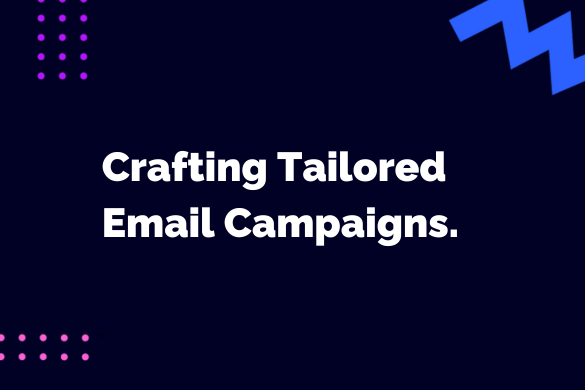
Comments are closed.